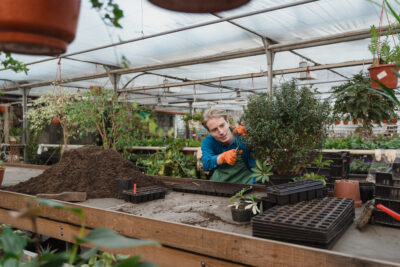
The Impact of Shallow Root Systems on Succulent Plants

Succulent plants, also known as water-storing plants, have gained significant popularity in recent years due to their unique ability to store water in their leaves, stems, and roots. These plants are well-adapted to arid environments and are known for their thick, fleshy leaves and stems. However, a lesser-known characteristic of many succulent plants is their shallow root systems, which play a crucial role in their growth and survival.
We will delve into the impact of shallow root systems on succulent plants. We will explore the reasons behind the evolution of shallow roots in these plants and how they contribute to their water storage capabilities. Additionally, we will discuss the challenges that shallow root systems pose for succulent plants, such as susceptibility to drought stress and limited nutrient uptake. Furthermore, we will examine the strategies employed by succulent plants to overcome these challenges and thrive in their natural habitats. By gaining a deeper understanding of the role of shallow root systems in succulent plants, we can appreciate the remarkable adaptations that allow these plants to thrive in harsh environments.
- Provide adequate drainage for succulent plants to prevent waterlogged soil
- Use a well-draining potting mix specifically formulated for succulents
- Water succulents sparingly to avoid overwatering and promote healthy root growth
- Provide sufficient sunlight for succulents to encourage strong root development
- Avoid overcrowding succulent plants to prevent competition for nutrients and space
- Use a balanced fertilizer formulated for succulents to support root growth
- Consider repotting succulents regularly to allow for root expansion
- Protect succulents from extreme temperatures to prevent stress on the roots
- Control pests and diseases that can damage succulent roots
- Avoid overhandling or disturbing the roots of succulent plants
- Frequently Asked Questions
Provide adequate drainage for succulent plants to prevent waterlogged soil
Succulent plants have unique adaptations that allow them to thrive in arid environments. One of these adaptations is their shallow root systems, which enable them to quickly absorb water when it is available. However, this adaptation also makes them susceptible to waterlogged soil, which can have a detrimental impact on their overall health.
When the soil around succulent plants becomes waterlogged, it can lead to root rot, a condition where the roots are unable to receive the necessary oxygen, resulting in their decay. This can weaken the plant's root system and eventually lead to the death of the plant.
To prevent waterlogged soil and promote optimal growth for succulent plants, it is crucial to provide them with adequate drainage. Here are a few methods to ensure proper drainage:
- Use well-draining soil: Succulent plants require a fast-draining soil mix that allows excess water to flow through easily. Avoid using heavy soil or those that retain moisture for too long.
- Add drainage materials: Incorporate materials such as perlite, pumice, or coarse sand into the soil mix to improve drainage. These materials help create air pockets and prevent water from pooling around the roots.
- Choose the right container: Opt for pots with drainage holes at the bottom to allow excess water to escape. It's also beneficial to use pots made of porous materials like terracotta, as they allow for better airflow and water evaporation.
- Water sparingly: Succulents have low water requirements, so it's important not to overwater them. Allow the soil to dry out completely between watering sessions to prevent waterlogging.
By following these practices, you can ensure that your succulent plants have the appropriate drainage they need to thrive. Remember, a healthy root system is essential for the overall well-being of succulents and their ability to store water efficiently.
 Are Succulents Affected by Overwatering?
Are Succulents Affected by Overwatering?Use a well-draining potting mix specifically formulated for succulents
Succulent plants, known for their ability to store water in their leaves and stems, have adapted to survive in arid conditions. One crucial factor in maintaining the health and longevity of succulents is ensuring that they are planted in a well-draining potting mix.
A well-draining potting mix is essential for succulents as it prevents water from pooling around the roots, which can lead to root rot and other problems. When selecting a potting mix for your succulents, look for one that is specifically formulated for their needs.
Why is a well-draining potting mix important?
Succulents have shallow root systems that are designed to quickly absorb water and nutrients from the soil. These roots are not adapted to survive in waterlogged conditions. If the potting mix does not drain well, the excess water will sit around the roots, causing them to rot and ultimately leading to the death of the plant.
What should a well-draining potting mix consist of?
A well-draining potting mix for succulents should consist of a combination of materials that allow water to pass through easily. Typically, such a mix includes ingredients like coarse sand, perlite, and pumice. These materials create air pockets within the mix, promoting proper drainage and preventing water accumulation.
 Using Sphagnum Moss as a Growing Medium for Succulents: Pros and Cons
Using Sphagnum Moss as a Growing Medium for Succulents: Pros and ConsHow to prepare a well-draining potting mix for succulents:
- Start with a base of potting soil specifically designed for succulents.
- Add coarse sand or perlite to the mix to improve drainage. These materials help create larger air spaces within the soil, allowing excess water to flow through.
- Incorporate pumice into the potting mix. Pumice is a lightweight volcanic rock that further enhances drainage by increasing the amount of air within the soil.
- Ensure that the potting mix is thoroughly mixed to distribute the components evenly.
Conclusion
Using a well-draining potting mix specifically formulated for succulents is crucial for their overall health and survival. By providing the right growing conditions, you can help prevent root rot and ensure that your succulents thrive in their environment.
Water succulents sparingly to avoid overwatering and promote healthy root growth
Succulent plants, known for their ability to store water in their leaves, stems, and roots, have adapted to survive in arid environments. One of the key characteristics that make succulents unique is their shallow root systems. Understanding the impact of shallow root systems on succulent plants is crucial for their care and maintenance.
Why do succulents have shallow root systems?
Succulents have evolved to have shallow root systems as a survival strategy. In their natural habitats, such as deserts and dry regions, water is scarce and unpredictable. Shallow roots enable succulents to quickly absorb any available moisture, efficiently utilizing it for their growth and survival.
The impact of shallow root systems
The shallow root systems of succulent plants have both advantages and disadvantages. On one hand, they allow the plants to quickly absorb water during periods of rainfall or watering. This helps the plants store water in their tissues, ensuring their survival during dry spells.
 Optimal Soil for Succulents: Understanding Preferred Types
Optimal Soil for Succulents: Understanding Preferred TypesHowever, shallow root systems also make succulents more prone to overwatering. When exposed to excessive moisture, the shallow roots can easily become waterlogged, leading to root rot and other fungal diseases. Therefore, it is essential to water succulents sparingly and provide proper drainage to prevent water from accumulating around the roots.
Tips for watering succulents
To promote healthy root growth and prevent issues caused by overwatering, here are some tips for watering succulents:
- Observe the soil moisture: Before watering, check if the soil is dry by inserting your finger about an inch into the soil. If it feels moist, hold off on watering until the soil dries out.
- Water deeply but infrequently: When watering, ensure that the water reaches the roots by soaking the soil thoroughly. However, avoid frequent watering as succulents prefer dry conditions.
- Use well-draining soil: Plant succulents in a well-draining soil mix specifically designed for succulents. This will prevent water from pooling around the roots.
- Avoid waterlogged pots: Use pots with drainage holes to allow excess water to escape. Empty the saucer or tray underneath the pot after watering to prevent the roots from sitting in standing water.
Understanding the impact of shallow root systems on succulent plants is essential for their care and maintenance. By watering succulents sparingly, providing proper drainage, and using well-draining soil, you can help promote healthy root growth and prevent issues caused by overwatering. Remember, succulents are adapted to survive in dry conditions, so it's better to underwater than overwater these fascinating plants.
Provide sufficient sunlight for succulents to encourage strong root development
Succulent plants are known for their ability to thrive in arid conditions, thanks to their unique ability to store water in their leaves, stems, and roots. However, one factor that can greatly impact the overall health and growth of succulents is the development of their root systems. In particular, shallow root systems can have a significant effect on the well-being of these plants.
One of the key factors in promoting strong root development in succulents is providing them with sufficient sunlight. Succulents are sun-loving plants that require ample exposure to sunlight to photosynthesize and produce energy. When succulents receive inadequate sunlight, their root systems may become shallow and weak.
Exposure to sunlight stimulates the production of auxins in succulent plants. Auxins are plant hormones responsible for root growth and development. When succulents receive an adequate amount of sunlight, the production of auxins is stimulated, leading to the formation of strong and deep root systems.
 Can Succulents Be Submerged in Water for Extended Periods?
Can Succulents Be Submerged in Water for Extended Periods?However, it is important to strike a balance when it comes to sunlight exposure. While succulents need sunlight to develop strong roots, excessive sunlight can also be detrimental to their overall health. Intense and prolonged exposure to direct sunlight can cause sunburn and damage to the plant's tissues, including its roots.
To provide sufficient sunlight for succulents, it is recommended to place them in areas with bright, indirect sunlight. South-facing windows or outdoor spots with partial shade are ideal locations for succulents to receive adequate sunlight without being exposed to intense rays for prolonged periods.
Additionally, if you notice that your succulent's root system is shallow or weak, you can consider using supplemental lighting, such as grow lights, to provide the necessary light energy for root development. This can be particularly helpful during the winter months when daylight hours are shorter and natural sunlight may be limited.
The impact of shallow root systems on succulent plants cannot be underestimated. Providing sufficient sunlight is crucial for encouraging the growth of strong and deep root systems in succulents. By ensuring optimal sunlight exposure, you can help your succulents thrive and maintain their overall health and beauty.
Avoid overcrowding succulent plants to prevent competition for nutrients and space
Succulent plants are known for their ability to store water in their leaves, stems, and roots, allowing them to survive in arid environments. However, one aspect that often goes unnoticed is the impact of shallow root systems on these plants.
Shallow root systems
 Can Succulents Thrive in Potting Soil or Do They Require Special Care?
Can Succulents Thrive in Potting Soil or Do They Require Special Care?Succulents have adapted to survive in harsh conditions by developing shallow root systems. Unlike other plants that have deep-rooted systems to anchor themselves and extract water from deeper soil layers, succulents have roots that spread out near the surface. These roots are excellent at absorbing water quickly after rainfall or irrigation, but they also make succulents more vulnerable to certain challenges.
Competition for nutrients
One of the main impacts of shallow root systems on succulent plants is the competition for nutrients. As the roots are closer to the surface, multiple succulent plants growing in close proximity can compete for the limited nutrients available in the topsoil. This competition can lead to nutrient deficiencies, affecting the overall health and growth of the plants.
Competition for space
In addition to nutrient competition, shallow root systems can also result in competition for space. Succulent plants tend to form dense clusters or clumps, especially when planted too closely together. As these plants grow, their shallow roots can intertwine and compete for space, limiting their ability to spread out and potentially causing overcrowding.
Effects of overcrowding
Overcrowding can have several negative effects on succulent plants. Firstly, it can hinder their access to sunlight. Succulents depend on sunlight to carry out photosynthesis, and when they are overcrowded, some plants may be shaded by others, leading to reduced growth and weakened overall health.
 Find the Best Soil for Your Succulents with Eb Stone
Find the Best Soil for Your Succulents with Eb StoneSecondly, overcrowding can increase the risk of disease and pest infestations. When succulents are congested, airflow is restricted, creating a favorable environment for the development and spread of fungal infections and pests. These issues can ultimately lead to the decline or death of the affected plants.
Preventing overcrowding
To prevent overcrowding and its negative impacts, it is essential to give succulent plants enough space to grow and thrive. When planting succulents, ensure that there is sufficient distance between each plant to allow for optimal root development and access to nutrients. Regularly monitor the growth of your succulents and consider transplanting or thinning out crowded areas if necessary.
Conclusion
While succulent plants have adapted to survive with shallow root systems, it is important to recognize the impact of these root systems on their overall health. By avoiding overcrowding and providing adequate space for growth, succulent plants can continue to thrive and showcase their unique beauty.
Use a balanced fertilizer formulated for succulents to support root growth
Succulent plants have shallow root systems that play a crucial role in their overall health and growth. These roots are designed to absorb water quickly and efficiently, allowing the plant to survive in arid environments. However, the shallow nature of these roots also makes them more vulnerable to certain challenges and stresses.
 The Soak and Dry Method for Succulents: A Comprehensive Guide
The Soak and Dry Method for Succulents: A Comprehensive GuideOne way to support the development and maintenance of healthy shallow root systems in succulents is by using a balanced fertilizer formulated specifically for these plants. A balanced fertilizer contains a mix of essential nutrients, such as nitrogen, phosphorus, and potassium, which are vital for root growth and overall plant health.
When using a balanced succulent fertilizer, it is important to follow the instructions provided by the manufacturer. Typically, this involves diluting the fertilizer with water and applying it to the soil around the base of the plant. This allows the shallow roots to absorb the nutrients gradually, without overwhelming the plant.
Benefits of using a balanced fertilizer for succulents:
- Promotes root development: The nutrients present in a balanced fertilizer help stimulate root growth in succulents. This is especially important for shallow root systems, as stronger and more extensive roots can improve the plant's ability to absorb water and nutrients from the soil.
- Enhances overall plant health: A well-nourished succulent is more resistant to diseases and pests. The balanced nutrients provided by the fertilizer support the plant's immune system and overall vitality, helping it thrive in various conditions.
- Improves drought tolerance: Succulents are known for their ability to withstand dry spells, but a balanced fertilizer can further enhance their drought tolerance. By promoting healthy root growth, the fertilizer helps the plant store and use water more efficiently, enabling it to survive longer periods without irrigation.
- Fosters better flower and foliage production: When succulents receive the right nutrients, they are more likely to produce vibrant flowers and foliage. A balanced fertilizer provides the necessary elements for robust growth, leading to visually appealing and healthy plants.
Remember to always choose a fertilizer specifically formulated for succulents, as these plants have unique nutrient requirements compared to other types of houseplants. By providing the right balance of nutrients, you can support the development and maintenance of healthy shallow root systems in your succulent plants, ensuring their long-term success and beauty.
Consider repotting succulents regularly to allow for root expansion
Succulent plants, known for their ability to store water in their leaves and stems, have adapted to survive in arid conditions. One of the key features of succulents is their shallow root systems, which play a crucial role in their survival. However, it is important to consider the impact of these shallow root systems on the overall health and growth of succulent plants.
One way to ensure the well-being of your succulents is to regularly repot them, providing ample space for their root systems to expand. When a succulent outgrows its current pot, its roots become crowded and can become root-bound. This restricts their ability to absorb nutrients and water, leading to stunted growth and potential health issues.
 Where to Find Succulent Soil at Home Depot: Your Guide to Buying
Where to Find Succulent Soil at Home Depot: Your Guide to BuyingBy repotting your succulents, you allow for the development of a more extensive root system. This enables the plant to access a larger area of soil, increasing its ability to absorb water and nutrients. As a result, your succulents will experience improved growth and overall vigor.
When repotting succulents, it is essential to use a well-draining soil mix specifically formulated for succulents and cacti. This ensures that excess water can easily drain away, preventing the roots from sitting in overly moist soil, which can lead to root rot.
Additionally, be sure to choose a pot that is slightly larger than the current one to provide adequate space for the root system to grow. Avoid pots that are too large, as this can lead to excessive soil moisture, which is detrimental to succulent plants.
Furthermore, when repotting, it is crucial to handle the succulent with care to avoid damaging the delicate root system. Gently loosen the roots from the old potting mix, removing any dead or rotting roots. Place the plant in the new pot, ensuring that the roots are spread out evenly. Fill the pot with the well-draining soil mix, pressing it gently around the base of the plant to provide stability.
Repotting your succulents regularly is essential for the expansion of their shallow root systems. By doing so, you provide them with the necessary space to grow and thrive. Remember to use a well-draining soil mix, choose an appropriate pot size, and handle the plant with care during the repotting process. Your succulents will thank you for it by displaying vibrant growth and health.
Protect succulents from extreme temperatures to prevent stress on the roots
Succulent plants have adapted to survive in arid environments by developing shallow root systems. These root systems enable them to quickly absorb water during periods of rainfall and store it in their leaves and stems for long periods of drought. However, this adaptation also makes them more susceptible to stress caused by extreme temperatures.
 Proper Watering Frequency for Repotted Succulents: A Guide
Proper Watering Frequency for Repotted Succulents: A GuideExtreme heat or cold can damage the delicate root structures of succulents, leading to reduced water absorption and nutrient uptake. This can result in poor growth, wilting, and even death of the plant. To ensure the health and longevity of your succulents, it is crucial to protect them from these temperature extremes.
Protecting succulents from extreme heat:
1. Provide shade: Place your succulents in areas that receive partial shade during the hottest parts of the day. This can be achieved by placing them under a tree, near a building, or using shade cloth.
2. Avoid direct sunlight: While succulents need bright light to thrive, intense and direct sunlight can scorch their leaves and roots. Consider placing them in areas with filtered or indirect sunlight.
3. Mulch the soil: Adding a layer of organic mulch around the base of your succulents can help regulate soil temperature and reduce heat stress. Use materials like wood chips, straw, or gravel.
Protecting succulents from extreme cold:
1. Bring them indoors: If you live in an area with harsh winters, it is advisable to bring your succulents indoors or place them in a greenhouse during the coldest months. This will protect them from freezing temperatures and frost.
2. Use frost blankets: If bringing them indoors is not an option, cover your succulents with frost blankets or burlap when frost or freezing temperatures are expected. This will provide some insulation and protect them from cold winds.
3. Avoid overwatering: During winter, succulents enter a period of dormancy and require less water. Overwatering during this time can lead to root rot and damage. Allow the soil to dry out between watering to prevent cold-related issues.
 Optimal Growth: Can Succulents Thrive in Potting Soil?
Optimal Growth: Can Succulents Thrive in Potting Soil?By taking these steps to protect your succulents from extreme temperatures, you can ensure their root systems remain healthy and thriving. Remember to monitor the weather conditions in your area and adjust your care accordingly. With proper care, your succulents will continue to bring beauty and joy to your indoor or outdoor space.
Control pests and diseases that can damage succulent roots
Succulent plants are known for their ability to store water in their leaves, stems, and roots. However, one of the challenges they face is having shallow root systems. Unlike other plants with deep root systems, succulent plants have roots that tend to stay closer to the surface of the soil.
This characteristic makes them more prone to damage from pests and diseases that can attack their roots. Therefore, it is crucial for succulent plant enthusiasts to take proper measures to control these issues and ensure the health and longevity of their plants.
Identify common pests and diseases
Pests:
- Mealybugs: These tiny white insects can infest the roots of succulent plants, sucking out their sap and causing wilting and yellowing of the leaves.
- Aphids: These small insects can also feed on the sap of succulent roots, leading to stunted growth and distorted leaves.
- Nematodes: These microscopic worms can cause root damage and hinder the plant's ability to absorb nutrients and water.
Diseases:
- Root rot: Overwatering can lead to root rot, a fungal infection that causes the roots to decay, resulting in wilted and discolored leaves.
- Fungal infections: Various fungal infections can attack succulent roots, causing root discoloration, decay, and overall plant decline.
- Bacterial infections: Bacteria can also infect succulent roots, leading to rot and tissue damage.
Preventive and control measures
Preventing and controlling pests and diseases that can damage succulent roots is essential for their well-being. Here are some measures you can take:
- Regularly inspect your plants: Regularly check your succulent plants for signs of pests or diseases. Look for wilting, yellowing, or distorted leaves, as well as any unusual growths or discoloration on the roots.
- Practice good watering habits: Avoid overwatering your succulents, as excess moisture can encourage root rot and fungal infections. Allow the soil to dry out between waterings.
- Use well-draining soil: Plant your succulents in a well-draining soil mixture specifically formulated for succulent plants. This helps prevent waterlogged roots and reduces the risk of root diseases.
- Isolate affected plants: If you notice any signs of pests or diseases, promptly isolate the affected plants to prevent the spread to other healthy plants.
- Apply appropriate treatments: Depending on the specific pest or disease, there are various treatments available, including insecticides, fungicides, and organic remedies. Consult with a gardening expert or do thorough research to determine the most suitable treatment for your situation.
By being proactive in identifying and addressing potential root issues, you can ensure the well-being and longevity of your succulent plants. Remember to maintain a healthy growing environment and monitor your plants regularly to catch any problems early on.
Avoid overhandling or disturbing the roots of succulent plants
When it comes to caring for succulent plants, one crucial aspect that often gets overlooked is the impact of their shallow root systems. Succulents, known for their ability to store water in their leaves and stems, have adapted to survive in arid environments with limited access to moisture. As a result, their root systems have evolved to be shallow and widespread, allowing them to quickly absorb water from the surface of the soil.
It is important to avoid overhandling or disturbing the roots of succulent plants, as this can disrupt their delicate balance and hinder their ability to absorb water effectively. When transplanting or repotting succulents, it is recommended to handle them with care and minimize any unnecessary disturbance to their root systems.
Benefits of shallow root systems
The shallow root systems of succulent plants offer several benefits that contribute to their overall health and survival. Firstly, shallow roots allow succulents to quickly absorb water after rainfall or irrigation, minimizing the risk of root rot caused by excess moisture. This adaptation is particularly advantageous in regions with sporadic rainfall or in containers where drainage may be limited.
Moreover, shallow root systems enable succulents to efficiently capture moisture from the air. Many succulent species have specialized structures on their leaves, such as trichomes, which help them absorb moisture from the atmosphere. These adaptations, combined with shallow roots, allow succulents to thrive in humid environments or during periods of high humidity.
Challenges and considerations
While shallow root systems provide numerous advantages, they also pose certain challenges for succulent plants. One of the main challenges is their susceptibility to drying out quickly. Since shallow roots are closer to the surface, they are more exposed to heat and evaporation, which can lead to rapid water loss. As a result, it is crucial to provide regular and adequate watering to keep the soil moist without causing waterlogged conditions.
In addition, the shallow nature of their roots makes succulents more vulnerable to physical damage. Accidental tugging or excessive disturbance can easily break or damage the delicate roots, which may disrupt their ability to uptake water and nutrients. Therefore, it is important to handle succulents with care and avoid unnecessary disruption to their root systems.
The shallow root systems of succulent plants play a vital role in their overall health and survival. These adaptations allow them to efficiently absorb water from the surface and capture moisture from the air. However, it is essential to handle succulents with care and avoid disturbing their roots to maintain their optimal functioning. By understanding and respecting the impact of shallow root systems, succulent enthusiasts can ensure the long-term well-being of these unique and fascinating plants.
Frequently Asked Questions
1. What are shallow root systems?
Shallow root systems are root systems that are closer to the surface of the soil, typically within the top few inches.
2. Do succulent plants have shallow root systems?
Yes, most succulent plants have shallow root systems as they have adapted to arid environments with limited water availability.
3. How do shallow root systems impact succulent plants?
Shallow root systems help succulent plants efficiently absorb water during rainfall or irrigation, but they make the plants more vulnerable to drought and wind damage.
4. Can shallow root systems be beneficial for succulent plants?
Yes, shallow root systems allow succulent plants to quickly absorb water and nutrients when available, which helps them survive in their natural habitats with sporadic rainfall.
If you want to read more articles similar to The Impact of Shallow Root Systems on Succulent Plants, you can visit the Watering and Soil category.






You Must Read